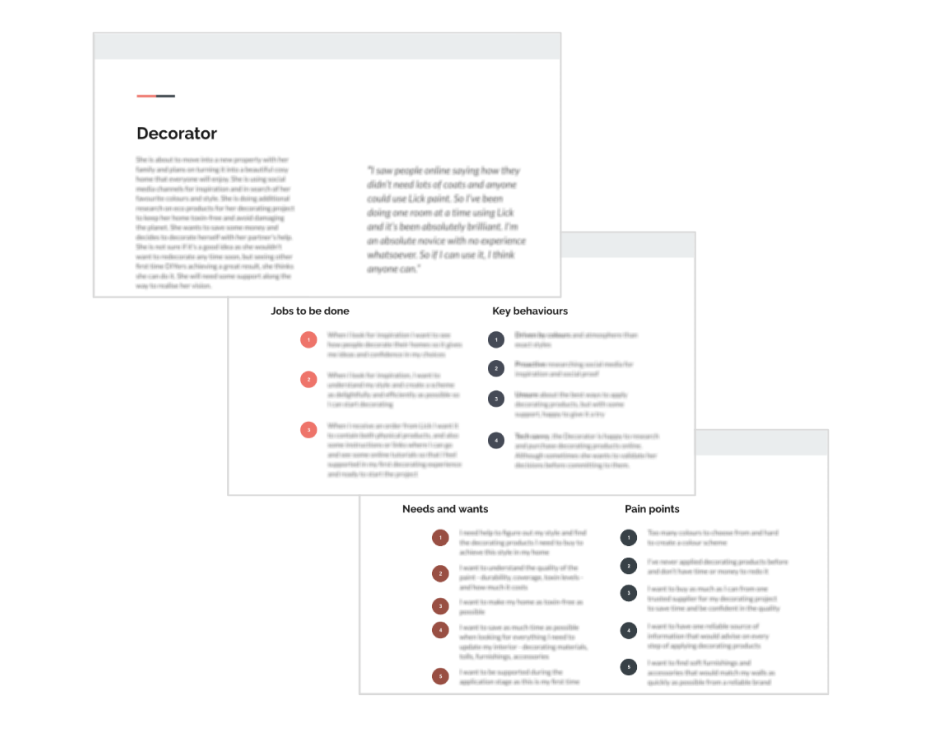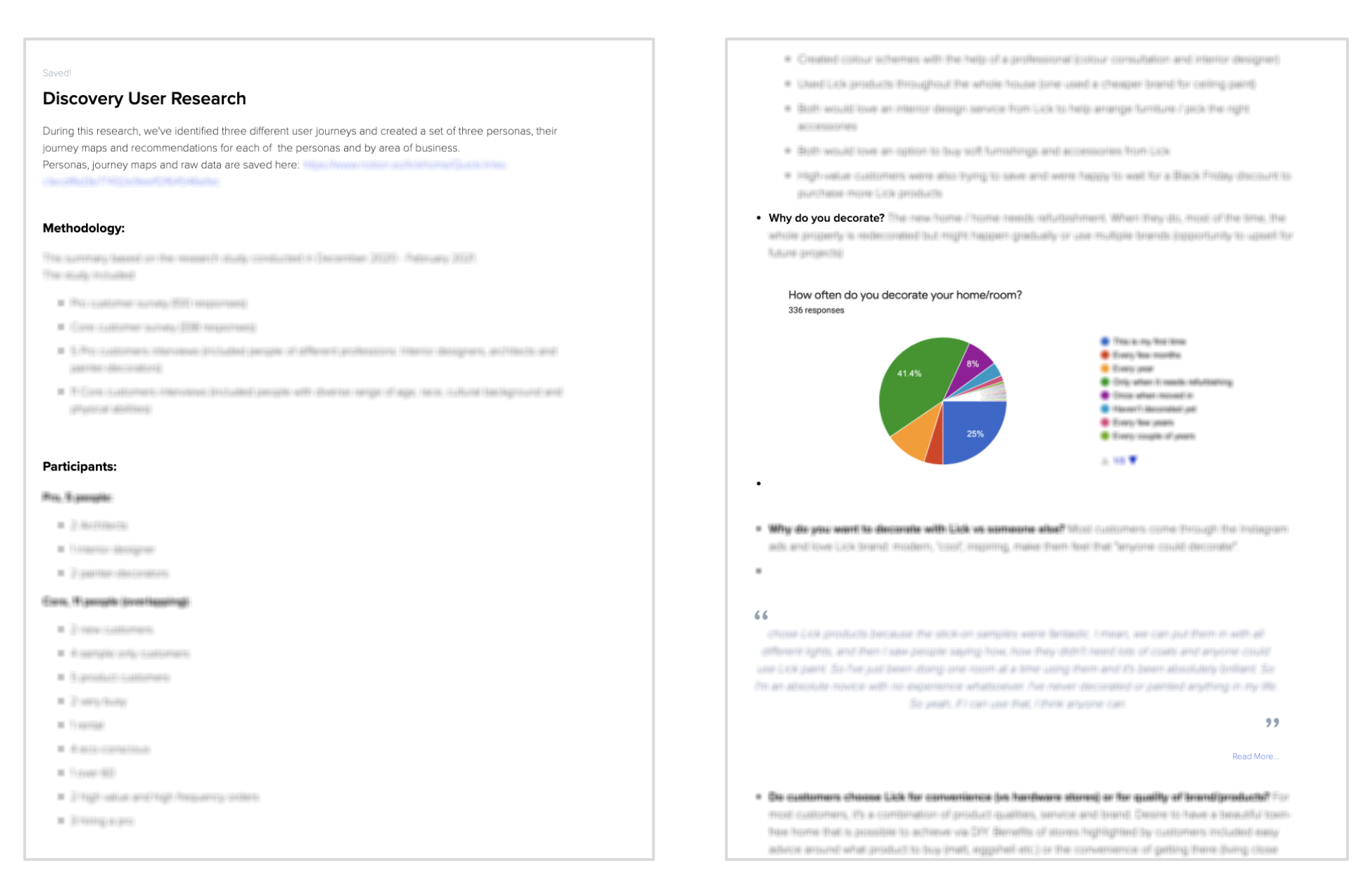Inclusive discovery
research for Lick.
We helped Lick better understand their audience, expand the range of perspectives about their products and services and make informed decisions when growing their digital and physical products.
About Lick.
Lick is a disruptive home decor brand that helps people transform their homes with ease and a smile. They focus on sustainability and industry-leading community building.
Lick is replacing the stresses of the outdated decorating industry with a simplified journey and customer-centric experience online. Helping customers make confident decisions and create spaces they love to spend time in.
Objectives.
Being a customer-centric brand, Lick wanted to learn more about the decorating journeys of their new and existing customers to better understand their needs, wants, motivations, pain points and Jobs-to-be-done.
Lick were also looking for ways to garner feedback about their brand, social media accounts and user experience of the website. To achieve this we’ve applied our experience in service design and went beyond digital products to understand customer experience with all touch points.
Methodology.
We used a wide range of methodologies and tailored them based on the goals of a business and specific research project. We started this project with an objective setting workshop to fully understand the goals, the definition of success and to find the best ways of achieving them.
Workshops and presentations.
For the workshops, we engaged people from various business areas to understand the full picture and align the vision for the project. Along the way, we facilitated additional workshops and presentations to ensure that the wider team is up to date with the project's progress and can input at any point. We also shared top findings from the surveys and interviews in real-time to engage the team in the project and take them on a journey.
Two surveys with different groups of users.
The best way to answer some of the questions set by the team was to publish two surveys with two groups of customers. Findings from the surveys showed us the bigger picture, answered some of the questions, and helped mitigate our internal assumptions. The results highlighted clear trends and helped the team decide on the directions they wanted to explore further. Based on the survey answers, we recruited a particular sample of interview participants and started the next phase of the project on a solid foundation.
Three groups of interviews.
After agreeing on the sample of research participants and aligning on the overall questions we wanted to dig into, we had a workshop to create a discussion guide and pick a journey to take customers through as a part of an interview. We agreed to include a diverse group of people in the interviews, including:
People with different levels of decorating experience and confidence
People with different levels of physical abilities and physical requirements for decorating products
People with diverse racial and cultural backgrounds
People of different age and gender
People with different amounts of time available for decorating
This allowed us to highlight extreme needs and drive a better user experience for all.
Inclusive design presentation.
We also shared some insights and benefits of Inclusive design with the wider company which had a great response.
Presentation “Inclusive design methodologies and application” at Lick, 2021
Deliverables.
Inclusive personas.
One of the objectives of the research for Lick was to identify the core customer personas. Based on the surveys and interview insights, we specified three core personas and documented each of these persona’s characteristics. These inclusive personas focused on the context, the story, the most important Jobs-to-be-done, key behaviours, needs and wants and pain points rather than demographics.
Journey maps and Jobs-to-be-done.
One of the key deliverables of this project was a series of journey maps, one for each persona. The journey maps outlined the steps in every persona's decorating journey. We used the Jobs-to-be-done statements to describe what goals people have at every step of the map. We also prioritised these statements to highlight the most critical findings. Later, they became the basis for user stories and ideation sessions.
Actions per department.
For Lick's discovery research, we collated all the data in the research repository tool EnjoyHQ. It allowed us to transcribe all the videos and bring the transcriptions together with the notes and survey results in one place, which helped to analyse the data. The summary and actions document contained quotes, video clips, graphs, answers to the department's original objectives and actions based on the discovered insights. The in-house design team used this repository for future projects.
Inclusive design presentation.
The inclusive design presentation had a positive response from the customer-centric team at Lick. It helped align the team with inclusive research methodologies and informed inclusive strategies for various departments.
Outcomes.
Uncovering of customer insights.
The results of the surveys and interviews helped Lick better understand their audience, expand the range of perspectives about their products and services.
Conversion uplift.
The research also informed the redesign of the Product Details Page which resulted in +7.65% increase in product conversion.
Growth opportunities.
Speaking to a diverse group of customers proved some original hypotheses and opened up unexpected insights and, therefore, new directions for growth.
Informed strategy.
The insights of this research informed Lick’s roadmap for the following year and helped prioritise future projects.
Answered questions.
This project answered the team's questions from the start of the project. The learnings were applied by various teams across the business, including Product Design, Pro, Brand, Marketing, Content and Physical Product. The new insights raised a series of further questions that became the basis for the follow-up research projects we worked on with Lick.
Up-to-date documentation.
The documentation produced for this project intentionally had a format that encouraged collaboration between teams and keeping these documents up-to-date with any new learnings about people or products. The wider team still uses the documentation and includes the latest insights.
Noëla Parant, Digital Product Design and User Research Lead, Lick Home.
“This discovery research led by Inclusive by Design has been a truly eye-opening experience. We’ve heard invaluable insights from our diverse group of customers and learned how we could evolve our products, help our customers with their decorating projects and reach more people in meaningful ways. Inclusive by Design created a set of actionable insights that are easy to read and help strengthen the product and brand.
They also shared knowledge and insights about inclusivity that everyone found inspiring and impactful.”
We loved working with Lick on this project! Being an open-minded, curious, highly creative and intelligent team meant that together we could bring and apply the value of the customers' insights to the business and the products in a short time. Each member of the wider multidisciplinary project team observed at least one interview, which helped build empathy with the customers and align around helping them achieve their goals.
Interestingly, the team found the interviews with the members of diverse groups most interesting and valuable. They led to significant discoveries and transformational ideas.
Inclusive by Design is also delighted to continue working with Lick to research deeper on specific topics with the follow-up research projects.
Would you like to do the same for your company?
Prefer a regular email?
Let us know about yourself and how we might be of help to you.
Email us on:










